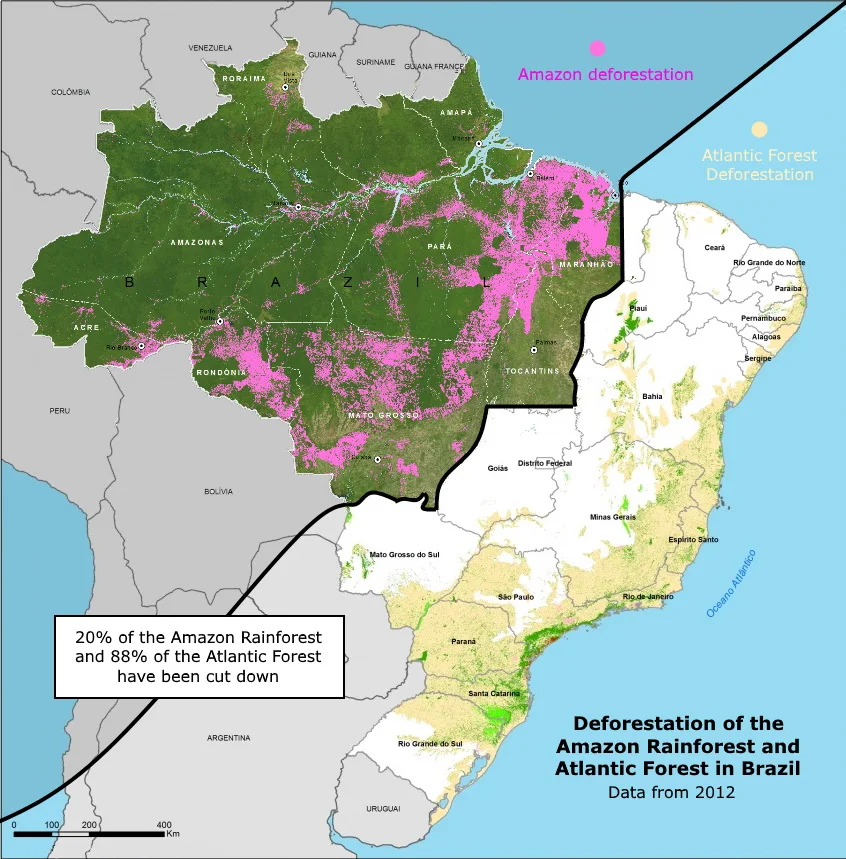Brazil’s lush landscapes, home to two of the world’s most iconic forests, the Amazon rainforest and the Atlantic Forest, are facing a dramatic transformation. The tales of these forests’ deforestation are as captivating as they are alarming, filled with both shocking statistics and fascinating insights into the complex interplay between nature and humanity.
The Amazon Rainforest: Earth’s Lungs
Often referred to as the "lungs of the Earth," the Amazon rainforest is an unparalleled natural wonder. Covering approximately 5.5 million square kilometers, it’s a verdant labyrinth teeming with life. However, this vast expanse is shrinking at an alarming rate. In 2022 alone, over 11,000 square kilometers were deforested—an area roughly the size of Jamaica!
The Chainsaw Chronicles
Deforestation in the Amazon is driven by several factors, but the leading culprit is agriculture. Imagine vast tracts of land, cleared for cattle ranching and soybean farming, emerging from what was once dense jungle. This conversion process is nothing short of a dramatic transformation. The sight of bulldozers plowing through centuries-old trees might seem like a scene from an action movie, but it’s a stark reality in the Amazon.
The Atlantic Forest: A Hidden Gem
While the Amazon grabs most of the headlines, the Atlantic Forest (Mata Atlântica) is another Brazilian treasure under threat. Once stretching along Brazil’s Atlantic coast, this forest has been reduced to a mere 12% of its original size. It’s a story of dramatic loss, yet it also holds tales of resilience and recovery.
Biodiversity Bonanza
Despite its reduced size, the Atlantic Forest remains a hotspot for biodiversity. Imagine walking through this forest and encountering species found nowhere else on Earth. It’s like stepping into a real-life Jurassic Park, minus the dinosaurs but with an abundance of unique flora and fauna. The forest's deforestation story is also a narrative of hope, with numerous conservation projects working tirelessly to restore its splendor.
The Human Element: Heroes and Villains
Deforestation is often depicted as a battle between good and evil. On one side, you have the loggers and developers, seen as the villains. On the other, there are the conservationists and indigenous communities, the unsung heroes fighting to protect their homeland. This human drama adds a layer of intrigue to the deforestation narrative.
Indigenous Guardians
Indigenous communities in the Amazon and Atlantic Forests play a crucial role in conservation. Picture a group of indigenous warriors, using GPS technology and satellite images to monitor and protect their territories from illegal logging. It’s a fascinating blend of ancient knowledge and modern technology, highlighting the dynamic ways in which these communities defend their forests.
The Ripple Effect: Climate and Beyond
The impact of deforestation extends far beyond Brazil’s borders. The Amazon rainforest, for instance, plays a critical role in regulating the global climate. When trees are felled, they release stored carbon dioxide, contributing to global warming. It’s a butterfly effect on a grand scale, where the actions in one part of the world reverberate across the globe.
Entertaining Insights
- Amazonian Whisperers: Did you know that the Amazon rainforest generates its own weather? The trees release water vapor through a process called transpiration, which helps form clouds and even influences weather patterns as far away as North America.
- Green Gold Rush: The Atlantic Forest is home to some of Brazil’s most famous products, including coffee and cocoa. Imagine your morning cup of coffee or your favorite chocolate bar—chances are, they have roots in this beleaguered forest.
The Path Forward: A Call to Action
The future of the Amazon and Atlantic Forests hangs in the balance. However, the tide is turning with increased awareness and action. Governments, NGOs, and local communities are working together to implement sustainable practices and restore degraded lands.
Join the Fight
Whether it’s supporting conservation efforts, advocating for sustainable products, or simply spreading the word, everyone can play a part in protecting these forests. After all, the story of deforestation is not just Brazil’s story—it’s a global saga, with a cast of billions and a setting that spans the entire planet.
Interested in learning more about the Amazon rainforest? Check out the following books:

This post may contain affiliate links. As an Amazon Associate, I earn from qualifying purchases.
Comments
Post a Comment